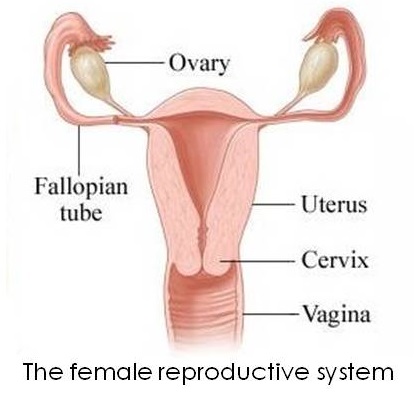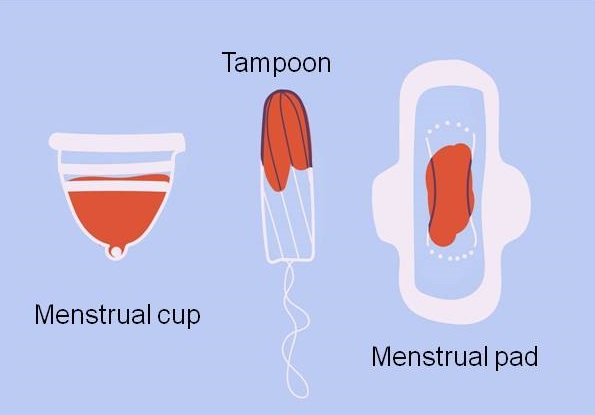By: Blessing Obialor. Freelance Health Writer and Datelinehealth Africa (DLHA) Volunteer, with medical review and editorial support from the DLHA Team.

Three young women standing together with heads touching.
The female body can be likened to a beehive of activities and there is not a moment when the reproductive system isn’t at work.
The Menstrual Cycle is one of several reproductive system activities going on in the female body.
In very simple terms every month the female body produces eggs which are meant to be fertilised by the male sperm. During this period as the female uterus prepares to receive the fertilised egg, its walls become thickened and supple.
If fertilisation does not occur the body signals the uterus to release the matured egg and the contents of the already prepared walls out of the body. This results in menstruation.
However, it’s important to recognise that the menstrual cycle is different from menstruation.
Menstruation is defined as the periodic discharge of blood and mucosal tissue from the inner lining of the uterus through the vagina. But the menstrual cycle is the series of phases under the control of the female hormones that leads to menstruation.
 The female reproductive system is made up of ovaries, fallopian tubes, uterus, accessory glands, vagina and external genital organs, which play major roles in the menstrual cycle.
The female reproductive system is made up of ovaries, fallopian tubes, uterus, accessory glands, vagina and external genital organs, which play major roles in the menstrual cycle.
The menstrual cycle is sometimes difficult to understand because of the number of overlapping phases and different changes. However, it is still important for every woman to understand her body and the changes taking place.
In this article we’ll offer an illustrated breakdown of the different phases of the menstrual cycle, including the time frame, menstrual blood composition, fertile window and menstrual disorders.
Let’s dive into the topic to start learning the true facts behind the menstrual cycle.
It is important for every African woman to have a good understanding of her menstrual cycle as it plays a major role in ensuring overall reproductive health.
Figure 1: Four phases of the menstrual cycle. Clcik image to enlarge. Credit
The menstrual cycle can be divided into two major stages with four phases:
Ovulation
This is the first phase of the menstrual cycle. It starts on the first day of your menstrual period and is characterised by menstruation; i.e., your monthly bleeding. When the mature egg isn't fertilized, hormones called progesterone and oestrogen decline leading to shedding of the uterine walls. The contents of this discharge will include blood, mucus and tissue.
You can use sanitary pads, tampons, period underwear or menstrual cups to absorb your period (figure 2)

Figure 2: Cartoon illustration of some imenstrual hygiene products used to absorb menstrual bleeding
The pads and tampons need to be changed regularly (preferably every three to four hours). Sanitary cups must be changed every 8 to 12 hours.
Regrettably,these menstrual hygiene products may be hard to find or not affordable to many sub-Sahara African women and young girls living especially in rural communities. These challenges pose grave health harzard to such people.
This phase may last 3 to 7 days with a typical average of 4 days.
Symptoms during the phase include; abdominal cramps, fatigue and brain fog.
The late follicular phase overlaps with the menstrual phase. It starts approximately on the sixth day of the cycle, lasts for about a week and ends on the first day of ovulation.
The pituitary gland, a small peanut like tissue that is attached to the base of the middle of the brain, releases Follicle Stimulating Hormone (FSH) which acts on the ovaries. The ovaries in response release about 5 to 15 follicles which each contain an immature egg. At the end of this phase only one or two (in rare cases) follicles survives and goes on to the next phase. During the late follicular phase, the endometrium (i.e., the lining of the uterus) that was shed during the early follicular phase is rebuilt or proliferates under ooestrogen priming and becomes thicker; ready for implantation.
Symptoms during this phase include; increase in energy levels, strength and mental focus.
On an average the early and late follicular phases last about 13 to 14 days, ending in ovulation.
The ovulation marks the end of the late follicular phase and the beginning of the luteal phase.
It is the period when your ovary releases a mature egg and lasts for 12 – 24 hours.
During the follicular phase, there’s a surge in oestrogen levels which leads to the release of Luteinizing Hormone (LH) from the anterior pituitary gland that initiates the release of the matured egg (i.e. ovulation). This occurs at approximately the 14th day of the menstrual cycle.
Ovulation date can vary in a woman from cycle-to-cycle, and not unusually, ovulation may not take place in a cycle.
For women with varying cycle length you can calculate the middle of your cycle.
After release, the egg enters into and journeys through the fallopian tube to the uterus for fertilisation.
Common symptoms during this phase include; heightened energy levels and socialisation. Some women may have ovulation cramps and feelings of depression
The early to mid-Luteal phase is the period after ovulation to about seven days before the start of menstruation.
After the release of the egg, the remaining part of the follicle is referred to as Corpus Luteum. This structure continues to produce some oestrogen but high levels of progesterone. These hormones are responsible for keeping your uterine lining prepared for implantation of the fertilised egg.
If pregnancy doesn't occur the luteum degenerates and is absorbed back into the body. If pregnancy occurs the corpus luteum lasts for 10 weeks before absorption occurs.
Symptoms during this phase may include; early experience of premenstrual syndrome, drop in energy and socialisation and increase in body temperature due to increased metabolism.
This happens about seven days before the start of your menstrual period begins and extends typically to between 24- 28 days of the menstrual cycle.
During this phase ooestrogen and progesterone level drops gradually and signals to the body that fertilisation has not taken place. The drop in progesterone causes the uterine lining to break down thereby leading to menstruation.
Common symptoms during this period are collectively referred to as Premenstrual Syndrome (PMS). This is characterised by;
Now that you know the major components of the menstrual cycle, read on to learn more about other important concepts associated with the menstrual cycle.
The menstrual cycle is characterised by the presence of several hormones working together. These hormones are major players in the cycle and affect mood, energy, sexual drive, sleep and other body functions.
Follicle Stimulating Hormone (FSH) and Luteinizing Hormone (LH), Oestrogen and Progesterone are major hormones that are linked to the menstrual cycle. Let’s see how they affect your menstrual cycle (figure 3).
Figure 3: Chart presenting hormonal changes during the phases of the menstrual cycle. Click on image to enlarge. Credit
Follicle stimulating hormone (FSH) is produced in the anterior pituitary gland under the influence of Gonadotropin Releasing Hormone (GnRH) released from the hypothalamus. It stimulates the release of the follicles out of which one matures prior to ovulation.
The Luteinizing hormone (LH) is also produced in the anterior pituitary gland under the influence of GnRH released from the hypothalamus at the mid level of the base of the brain. LH stimulates the production of ooestrogen and progesterone by stimulating the release of the egg from the mature follicle.
Oestrogen (Estrogen) is a major hormone involved in the menstrual cycle. It is responsible for regulating the changes in the wall of the uterus (endometrial wall) and stimulating release of luteinizing hormone. It also inhibits the release of follicle stimulating hormone. Oestrogen plays a major role in mood regulation, bone strengthening and puberty.
Progesterone is majorly secreted by the corpus luteum in the second half of the menstrual cycle. This hormone prepares the uterus for fertilisation by acting on the uterine wall making it supple, thick and ready for the fertilised egg to implant.
These hormone work in very complex ways as illustrated in figure 4 to regulate the menstrual cycle in a healthy manner.
Figure 4: Showing the interplay of several hormones regulating the menstrual cycle. Click image to enlarge.
Click on the video icon below to get a pictoral description of the how the menstrual cycle works.
Video: How the menstrual cycle works. Click on the image to view.
The menstrual cycle is calculated from the last day of a period to the first day of the next period.
Cycle length is influenced by several factors which explain the difference across different individuals.
Averagely women who are not taking any form of contraception record a cycle length of between 24 to 38 days with a generally assumed average of 28 days. It's important to know that your cycle gives an insight into your general well being.
Therefore you should have an idea of your cycle length in order to adequately monitor changes in your body system.
However cycle length may not be the same for everyone and may vary in different seasons as a result of the following factors:
Many people have strange beliefs concerning the composition of menstrual blood. Most of these beliefs are myths. An extreme is the idea that menstrual blood is dirty or toxic. Contrary to this, menstrual blood is healthy blood.
Menstrual blood is just like every other blood that comes out of any part of your body, it contains:
This is the major constituent of menstrual discharge. Usually the colour may differ slightly based on the time taken to come out of the body. Deep red and brown bloods indicate that it may have taken a while to get out; whereas bright red blood indicates that the blood was freshly released from the uterus.
When considering the menstrual cycle, it was mentioned that the hormone ooestrogen prepares the endometrial lining for implantation of the fertilised egg. When this does not take place, the endometrial lining is released as clots of uterine tissue.
Throughout the menstrual cycle the body continuously releases secretions from the vagina and cervix. This doesn't stop during menstruation.
The vagina and cervix is filled with some naturally occurring bacteria that help to maintain the pH of the vagina.

Two young smiling women standing together having fun
Have you ever experienced the phenomenon called menstrual syncing?
Menstrual syncing, also known as period synchrony or the McClintock effect, is a belief that women who live together will begin to menstruate at the same time of the month.
The theory is based on the idea that certain pheromones in women who are in close contact interact with each other. There is no scientific evidence to back this up, hence we it can't be concluded that menstrual syncing actually happens.
The menstrual cycle doesn't always go as expected. Some women may experience a problem free cycle, while some may experience physical, emotional, and psychological symptoms before and during menstruation. These range from heavy bleeding, mood swings, and body pain most women suffer during their period.
A disorder is defined as anything out of the normal. Some of the disorders associated with the menstrual cycle include:
This cuts across a range of three major conditions:
This is characterised by scanty or no menstrual blood. This is normal during pregnancy or menopause but in the absence of any of these two it calls for immediate action.
Your periods are considered irregular if they occur less than 21 days or more than 35 days of one another. Irregular periods can affect anyone who has periods. It's more likely for your periods to be irregular when they first start and when you're nearing menopause.
There are many reasons why you may bleed between your periods. These may include:
According to statistics, one out of five women bleed heavily during their periods leading to a disruption in their activities of daily living. This disorder is characterised by the need to change sanitary pads every hour. Major causes of this disorder include:
Dysmenorrhea or excessive period pain is caused by the uterine contractions initiated by the action of hormones like prostaglandin. Note that cramps are a usual component of the menstrual cycle but become a major cause for concern when they are persistent and unbearably painful.
4. Premenstrual Syndrome (PMS)
This describes a variety of symptoms associated with the menstrual cycle. There are about 150 symptoms of PMS that can be classified into many broad categories like physical and emotional symptoms.
PMS is caused by the changes in the amount of hormones (oestrogen and progesterone) which in turn affects the amount of serotonin in the brain. This affects the mood regulation during the menstrual cycle.
The fertile window is closely related to your ability to conceive. It is made up of specific days in the menstrual cycle when the likelihood to conceive increases.
This period is usually a window of 5 days. That is 5 days before ovulation and includes the day of ovulation and day after ovulation.
Sperm and the egg have different periods of survival. The egg remains viable for only 24 hours while the sperm remains viable for 5 days.
Hence, it is possible for a woman to get pregnant during her fertile window and 24 hours after (as long as the egg remains viable), because the sperm can survive for 5 days.
The best time to get pregnant is within the first few hours of release of the egg. This is because every hour the egg loses its quality, it decreases the likelihood of conceiving.
The menstrual cycle gives a valuable insight into your reproductive health. It is therefore very important that you are aware and understand the changes that occur during cycle.
1. Moshin, A. How your hormones affect menstruation. Progressive Women’s Health. [Internet, n.d.]. Cited, March 5, 2024. Available from: https://www.progressivewomenshealthonline.com/blog/how-your-hormones-affect-menstruation
2. Society for Endocrinology (UK). You and Your Hormones. Menstrual cycle [Last reviewed, Feb. 2021]. Cited, March 5 2024. Available from: https://www.yourhormones.info/topical-issues/menstrual-cycle/
3. Care E, Mathari J. The Menstrual Cycle - Phases, hormones and their functions. [Internet, Dec. 21, 2019]. Cited, March 5, 2024. Available from: https://elara.care/hormones/menstrual-cycle-hormones-and-their-functions/.
4. Johns Hopkins Medicine. Calculating your monthly fertility window [Internet. N.d.] Cited, March 5, 2024. Available from: https://www.hopkinsmedicine.org/health/wellness-and-prevention/calculating-your-monthly-fertility-window.
Related:
12 Frequently Asked Menstruation Questions and Answers for Africans to Know
Amenorrhea: Causes, Symptoms, Diagnosis and Treatment
Pelvic Inflammatory Disease in Africa: Causes and Symptoms
Endometriosis: What you need to know
Fibroids: What every African woman should know
Published: March 12, 2024
Updated: April 4, 2024
© 2024. Datelinehealth Africa Inc. All rights reserved.
Permission is given to copy, use and share content for non-commercial purposes without alteration or modification and subject to attribution as to source.
DATELINEHEALTH AFRICA INC., is a digital publisher for informational and educational purposes and does not offer personal medical care and advice. If you have a medical problem needing routine or emergency attention, call your doctor or local emergency services immediately, or visit the nearest emergency room or the nearest hospital. You should consult your professional healthcare provider before starting any nutrition, diet, exercise, fitness, medical or wellness program mentioned or referenced in the DatelinehealthAfrica website. Click here for more disclaimer notice.